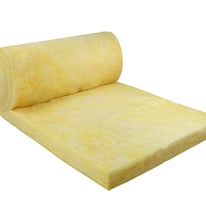
What is the thermal conductivity of glass wool?
4/11/20245 min read

Categories
Popular
Glass Wool Insulation





What is the thermal conductivity of glass wool?





What is the thermal conductivity of glass wool?
The thermal conductivity of glass wool is an important physical parameter that describes the material's ability to conduct heat energy. Before understanding the thermal conductivity of glass wool, let's first understand what thermal conductivity is and why it is important.
The thermal conductivity, usually represented by the letter k, is a measure of the efficiency of a substance in conducting heat energy. It is the amount of heat per unit area and temperature difference per unit time. Different materials have different thermal conductivity, which depends on their molecular structure, density, temperature, and other factors.
Glass wool is a material made from molten glass fibers, which has a high fiber density and low thermal conductivity. This makes glass wool a very effective insulation material, widely used in fields such as construction, industrial equipment, and pipeline insulation.
So, what is the specific thermal conductivity of glass wool? In fact, the thermal conductivity of glass wool is not a fixed value, and it is influenced by various factors, including the density, fiber diameter, fiber length, temperature, humidity, etc. of glass wool. In addition, the thermal conductivity of glass wool may also be affected by some parameters during the production process.
Therefore, to accurately answer the question "What is the thermal conductivity of glass wool?", we need more contextual information. For example, we need to know the specific specifications of glass wool (such as density, fiber diameter, etc.), as well as the environmental conditions for measuring thermal conductivity (such as temperature, humidity, etc.).
Generally speaking, the thermal conductivity of glass wool can be found in its product specifications or technical data sheets. These documents usually provide thermal conductivity values under different conditions for user reference.
In addition to product specifications and technical data sheets, we can also obtain more detailed thermal conductivity information by consulting relevant scientific literature or contacting glass wool manufacturers. These resources may provide experimental data, theoretical analysis, and application cases related to the thermal conductivity of glass wool.
It should be noted that the measurement and calculation of thermal conductivity is a relatively complex process that requires professional equipment and methods. Therefore, for ordinary users, understanding the range of thermal conductivity and application scenarios of glass wool may be more practical.
Overall, the thermal conductivity of glass wool is an important physical parameter that determines its performance as an insulation material. To accurately understand the thermal conductivity of glass wool, we need to consider multiple factors and refer to relevant product specifications, technical data sheets, or scientific literature. Meanwhile, we also need to note that measuring and calculating thermal conductivity is a relatively complex process that requires professional knowledge and equipment.
Shenzhou Energy Saving Technology Group Co., Ltd. is an energy saving and environmental protection enterprise integrating research and development, manufacturing and service of thermal insulation and sound absorption and noise reduction materials. The Group has six subsidiaries and ten industrial parks, producing five main series of products of rubber foam, glass wool, ceramic wool, sound absorption and noise reduction materials, and rock wool. Its products are widely used in construction, central air conditioning, refrigerator refrigeration, petrochemical, Marine locomotive, aerospace, thermal power, sound-absorbing noise reduction, and other industries.
After more than 40 years of exploration and sharpening, Shenzhou Group has become a leading manufacturer in the heat insulation and energy saving industry . The group covers an area of 1.06 million square meters, including a construction area of 680,000 square meters. Euipped with internationally advanced production equipment and technology, Shenzhou’s annual production volume of rubber foam is 2.6 million m³, glass wool 230,000 tons, rock wool 120,000 tons, and ceramic wool 28,000 tons. While solving the employment issue of more than 2,000 people, Shenzhou also created considerable economic and social benefits.

FAQ
1. Are you a manufacturer or a trading company?
We are a manufacturer which has 40 years' history.
2.Is your company OEM or ODM?
We not only make products, we design them.
3.Where is your manufacturer? How to visit it?
Our company is located in Dacheng town, Langfang City, Hebei province, China.Operating glass wool, rubber foam, ceramic wool, rock wool, sound-absorbing panels and other products.You can take a plane to Beijing, then take the subway for 20 minutes to our company.
4.How we control and ensure product quality?
We have a professional technical team and R&D center and have obtained many international certifications.
5.Can I customize the product?
Certainly! We are more than willing to accommodate customer requests. If you have any further inquiries, please feel free to reach out to us.


About Us
Click the button below to get more information about us
Newsletter
Click to subscribe for more information
Follow Us
Contact Us
Address
Dacheng town, Langfang City, Hebei province, China
Phone
+86 185 03165 626
